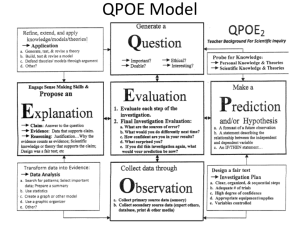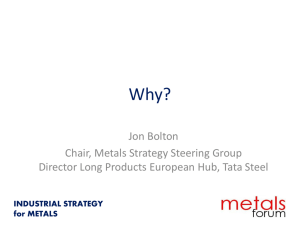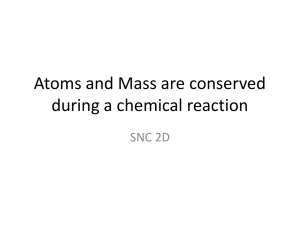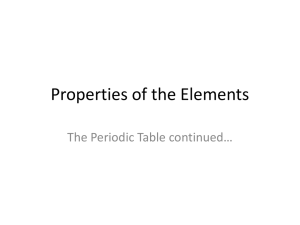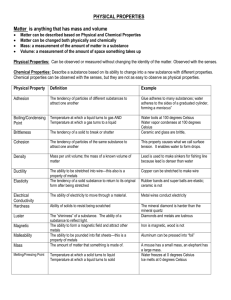Bioaccumulation of Nine Heavy Metals in water, sediments and soft
advertisement
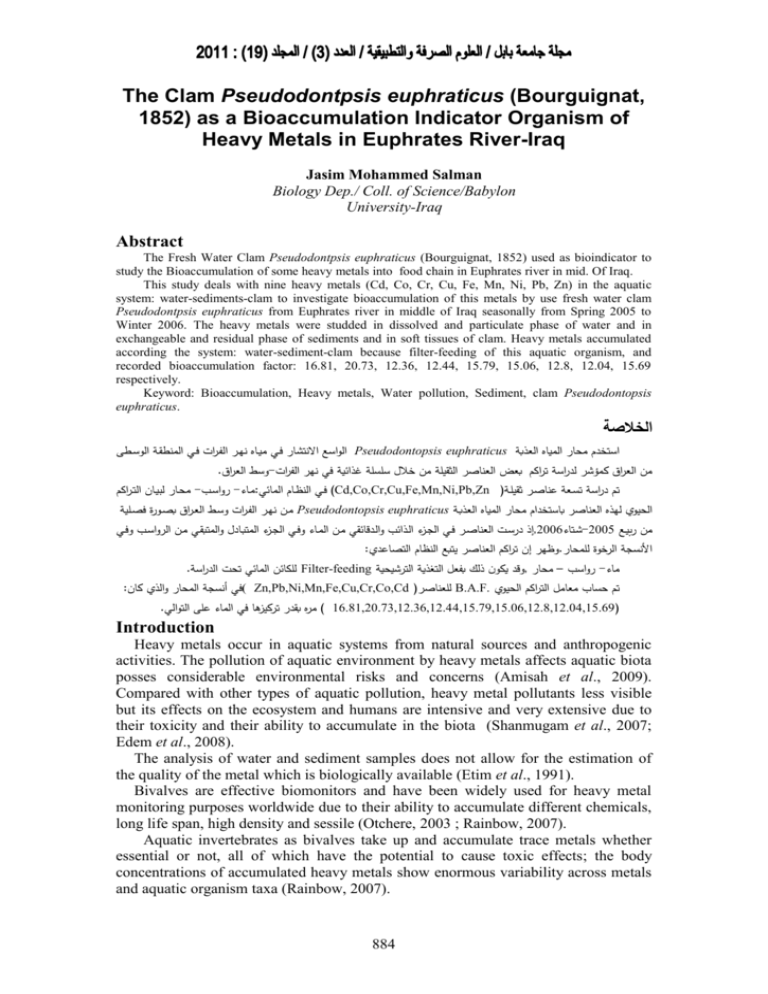
The Clam Pseudodontpsis euphraticus (Bourguignat, 1852) as a Bioaccumulation Indicator Organism of Heavy Metals in Euphrates River-Iraq Jasim Mohammed Salman Biology Dep./ Coll. of Science/Babylon University-Iraq Abstract The Fresh Water Clam Pseudodontpsis euphraticus (Bourguignat, 1852) used as bioindicator to study the Bioaccumulation of some heavy metals into food chain in Euphrates river in mid. Of Iraq. This study deals with nine heavy metals (Cd, Co, Cr, Cu, Fe, Mn, Ni, Pb, Zn) in the aquatic system: water-sediments-clam to investigate bioaccumulation of this metals by use fresh water clam Pseudodontpsis euphraticus from Euphrates river in middle of Iraq seasonally from Spring 2005 to Winter 2006. The heavy metals were studded in dissolved and particulate phase of water and in exchangeable and residual phase of sediments and in soft tissues of clam. Heavy metals accumulated according the system: water-sediment-clam because filter-feeding of this aquatic organism, and recorded bioaccumulation factor: 16.81, 20.73, 12.36, 12.44, 15.79, 15.06, 12.8, 12.04, 15.69 respectively. Keyword: Bioaccumulation, Heavy metals, Water pollution, Sediment, clam Pseudodontopsis euphraticus. الخالصة الواسع االنتشار في ميياه ن ير التي ار في المنلوية الوسيلPseudodontopsis euphraticus استخدم محار المياه العذبة .وسط العراق- من العراق كمؤشر لدراسة تراكم بعض العناصر الثويلة من خالل سلسلة غذائية ف ن ر الت ار محيار ليييان التيراكم- رواسي- ) في النايام المائ امياCd,Co,Cr,Cu,Fe,Mn,Ni,Pb,Zn تم دراسة تسيعة نناصير ثويلية مين ن ير التي ار وسيط العيراق بصيورة فصيليةPseudodontopsis euphraticus الحيوي ل ذه العناصر باستخدام محار المياه العذبية وفي واليدمائو مين الميا وفي ال يل المتبيادل والمتبوي مين الرواسي العناصير في ال يل اليذائ إذ درسي,2006 شيتا-2005 من ربييع وا ر إن تراكم العناصر يتبع الناام التصانديا.األنس ة الرخوة للمحار .الدراسة للكائن المائ تحFilter-feeding ومد يكون ذلك بتعل التغذية الترشيحية, – محار رواس- ما (ف أنس ة المحار والذي كاناZn,Pb,Ni,Mn,Fe,Cu,Cr,Co,Cd للعناصرB.A.F. معامل التراكم الحيوي تم حسا . ) مره بودر تركيلها ف الما نل التوال16.81,20.73,12.36,12.44,15.79,15.06,12.8,12.04,15.69 Introduction Heavy metals occur in aquatic systems from natural sources and anthropogenic activities. The pollution of aquatic environment by heavy metals affects aquatic biota posses considerable environmental risks and concerns (Amisah et al., 2009). Compared with other types of aquatic pollution, heavy metal pollutants less visible but its effects on the ecosystem and humans are intensive and very extensive due to their toxicity and their ability to accumulate in the biota (Shanmugam et al., 2007; Edem et al., 2008). The analysis of water and sediment samples does not allow for the estimation of the quality of the metal which is biologically available (Etim et al., 1991). Bivalves are effective biomonitors and have been widely used for heavy metal monitoring purposes worldwide due to their ability to accumulate different chemicals, long life span, high density and sessile (Otchere, 2003 ; Rainbow, 2007). Aquatic invertebrates as bivalves take up and accumulate trace metals whether essential or not, all of which have the potential to cause toxic effects; the body concentrations of accumulated heavy metals show enormous variability across metals and aquatic organism taxa (Rainbow, 2007). 884 Journal of Babylon University/Pure and Applied Sciences/ No.(3)/ Vol.(19): 2011 Any aquatic bivalves will take up heavy metals into the body from solution through permeable body surface and from gut and that uptake of metals from water, sediment and diet (Wang, 2002), or by biosorption (Soliman, 2006). The accumulation of metals in bivalves is variable according to age and sex of organism and temperature and salinity of water (Barsytelovjoy, 1999). Metal concentrations in aquatic mollusks are influenced by many external factors such as season, pH, hardness of water, concentration and composition of particulate matter (Barsytelovejoy, 1999). Accumulated metal that has been detoxified and metal that is available metabolically to play an essential and in extreme circumstances a toxic role in biochemistry (Rainbow, 2002). Many studies deal with the bioaccumulation of heavy metals in aquatic mollusks (e.g. clam, oysters & other) in different aquatic systems and in many sites of world such as (Demina et al., 2009; Netpae & Phalaraksh, 2009; Amisah et al., 2009; Shanmugam et al., 2007; Liu et al., 2007; Turkmen et al., 2005; Ohimain et al., 2008; Gaber et al., 2008; Salman, 2006). The aim of this study is to evaluate the seasonal bioaccumulation of nine heavy metals in dissolved and particulate phase of water and residual and exchangeable phase of sediments and soft tissue of fresh water clam Pseudodontopsis euphraticus (Bourguignat, 1852) living in Euphrates river in middle of Iraq . Material & Methods Fresh water clam Pseudodontopsis euphraticus collected from Euphrates river (in middle of Iraq) near Hindia, Kafel, and Kufa Townes, during Spring 2005 to Winter 2006. After all samples were removed from the substratum with a new stainless steel scraper, they were washed with clean river water at the site of collection, separated to species, placed in a clean plastic bag and transferred in a cool box to laboratory at the same day and then frozen at( -20 C°) until dissection (Turkmen et al., 2005). All bottles were cleaned with 10% HNO3 then rinsed with distilled water prior to use. Clam samples were cleaned to remove mud and debris and subsequently washed with double distilled water, specimens were divided according to their size and 25 individual were obtained for each size class. There were (3) replicates for clam under study. Soft tissue of clam dried at 40-45 C° in overnight. The extraction and determination of heavy metals in clam soft tissues doing according to (Davies et al., 2006). Water samples were collected from same site of clam collection by polyethylene bottles in 3 L to replicate and filtration by Millipore filter paper 0.45 µm, 47 mm diameter and preconcentration according to (Riley & Taylor, 1968), to determined the concentration of dissolved heavy metals. Filter paper digested to determined the particulate heavy metals in water (Sturgeon, 1982). Sediment samples collected from the region near clam by Grab sampler, surface layer to 5 cm used to study of exchangeable and residual of heavy metals in these sediments according to (Madkour, 2005). The analytical blanks were run in the same way as the samples and concentrations were determined using standard solutions prepared in the same acid matrix (Turkmen, 2003). Concentrations of heavy metals in water, sediments and soft tissues of clam were determined using pyeunicam Sp9 air-acetylene scientific model of flame atomic absorption spectrophotometer (FAAS). Bioaccumulation factor determined according to (Demina et al., 2009) as: 885 conc. of metals in clam ( g/g) conc. of metals in water ( g/L) Statistical variation analysis and correlation coefficient (r) were obtained. B.A.F. Results & Discussion Tables (1, 2) and Fig.(1;2) showed the seasonal concentrations and yearly average of nine heavy metals studied in ecosystem of water, sediments and soft tissue of fresh water clam P.euphraticus. The dissolved concentrations of heavy metals under study in water ranged between 0.5 µg/L of Ni as lowest metal levels and 124 µg/L of Fe as highest metal levels. The study found highly variation in heavy metals concentration between different season in same metal or different metals, may be due to variation of heavy metals pollution source and differ of amount discharge to river through seasonal studies (Soliman, 2006), or because dilution factor or unstable of water levels in river under study (Kalff, 2002). High concentration of heavy metals were showed in particulate phase of water. The highest concentration of Fe is 632.41 µg/g dry weight was observed in Spring 2005 (Table-1). These concentrations increased in particulate phase compare to dissolved phase of heavy metals due to the increase in level of suspended matter by erosion process or soil drift from near land and rise of river slop (Rainbow, 2007), and tendency of heavy metals to adsorption on particulate matter surface in water column (Demina et al., 2009). Sediment analysis showed that the highest concentration of heavy metals was found in Euphrates river in period of study. The amount of heavy metals of (Cd, Co, Cr, Cu, Fe, Mn, Ni, Pb, and Zn) in exchangeable phase of sediment ranged (5.076.75), (4-4.11), (0.14-0.20), (6.97-7.46), (300.50-340.9), (17.25-17.50), (0.088-0.099), (0.241-0.273) and (29.99-31.20) µg/g dry weight respectively, but in residual phase the study showed high similarity in metals concentration with values of these metals in exchangeable phase of sediments (Table-1), of what to signal of similarity in pollution source through different time sequence (Barsytelovejoy, 1999), of what make the sediments as potential source to heavy metals pollution and transplantation of this metals through food chain to aquatic system (Ardalan et al., 2006). The increase of heavy metals concentration in sediments may be correlated with sediment count of organic matters and these concentrations were negative correlation with sediment grain size. These result agreed with study of (Salman, 2006) at refer to small grain size and tendency to (silt-clay) of Euphrates river sediments addition to exposure this sediment to discharged of industrial and domestic waste and mining (Chindah et al., 2004). Higher concentration of heavy metals in sediment than in water was observed in different studies and the major depository of metals in some cases, holding more than 99 percent of total amount of a metal present in the aquatic system (Netpae & Phalaraksh, 2009). In soft tissues of fresh water clam under study mean concentrations of metals followed the sequence Fe<Zn<Mn<Cu<Cd<Co<Pb<Cr<Ni and the yearly average of this heavy metals at (3.30), (26.96), (1.36), (47.15), (1964), (117.35), (0.64), (1.71) and (200.11) µg/g dry weight respectively. The rise of metals concentration in clam may be return to ability of bioaccumulation in soft tissues in high levels (Hedouin et al., 2007). In this field (Barsiene et al., 2002) referred to the bivalve have ability of metal accumulation in 1000/100 concentration in water the results of this study showed that the bivalves from Euphrates river follow normal patterns of heavy metal content variability, related to differences between stations and seasons. 886 Journal of Babylon University/Pure and Applied Sciences/ No.(3)/ Vol.(19): 2011 The metal concentrations measured reflect a clear influence of anthropogenic activities, additionally, the effective exposure of organisms to different metals may be influenced by either changes in metal speciation or relative distribution of metals between particles of different sizes and densities (Turkmen et al., 2005). The strong relationship showed between metal concentration in clam soft tissues and concentrations of these in particulate phase of water this due to the filter-feeding and detritus feeding of this organisms and the organism under study may be accumulate the different pollutants more than sediments and water (Madkour, 2005). The results of the study to show clear variance in concentration of heavy metals through study seasons may be due to effective of metals availability in aquatic organisms by different environmental factors such as pH, water hardness and amount and compound of particulate matters (Phillips, 1977), or may be as result of biological action change of this organisms and effected of amount of food and productivity by photoperiods (Chindah et al., 2004; Gbaruko & Friday, 2007). From statistical analysis the study showed significant variation (P<0.05) in metals concentration in water, sediment and clam between seasons, and showed some correlation between heavy metals under study such as dissolved Cd and Cd in clam soft tissue (P<0.05, r=-0.98), particulate Cd and residual Cd (P<0.05, r=0.99), dissolved and particulate Co (P<0.05, r=0.95), particulate, residual Mn, dissolved Mn and Mn in clam (P<0.05, r=-0.45, r=-0.98) respectively, but not found any correlation between other heavy metals. The present study deals with determination the mechanism of heavy metals accumulation through the system water-sediment-clam, than to observe the most metal under study to seize the same place in metals sequence in water, sediments and soft tissue of clam to confirm the interaction between the compound of this system, these result confirm in many studies (Soliman, 2006; Ardalan et al., 2006; Madkour, 2005; Barsytelovejoy, 1999; Turkmen, et al., 2005; Shanmugam et al., 2007; Netpae & Phalaraksh, 2009; Ohimain et al., 2008; Gabr & Gab-Alla, 2008; Liu et al., 2007; and Gbaruko & Friday, 2007). The pattern of variation of heavy metal accumulation in whole soft tissues of the clam appears to be influenced largely by the reproductive stage of the organism (Amisah et al., 2009). From the results (Table-2) become clear the different heavy metals under study Cd, Co, Cr, Cu, Fe, Mn, Ni, Pb, and Zn were accumulated in soft tissue of fresh water clam P.euphraticus by bioaccumulation factor (BAF) as (16.81, 20.73, 12.36, 12.44, 15.79, 15.06, 12.8, 12.04, & 15.69) than concentration in water respectively. This results provide good evidence of metals accumulation in aquatic organisms more than water and sediment that help use this organisms as bioindicators and as a good environmental tools to study of aquatic pollution (Hedouin et al., 2007). The study of bioaccumulation factor (BAF) in aquatic organism's tissues useful to explain the best organism have the ability of heavy metals bioaccumulation in environment and help to used this organisms as clam in environmental monitoring programs (Rainbow, 2007). Determination of harmful and toxic substances in water, sediments and biota, gives direct information on the significance of pollution in the aquatic environment (Gbaruk & Friday, 2007). 887 Table (1): Concentrations of heavy metals in water, sediments and soft tissues of fresh water clam P.euphraticus (µg/L to dissolved phase, µg/g to particulate phase and sediment and clam). Element concentration in water Element concentration sediment(ug\g) Dissolved 2.50 1.55 1.70 2.65 0.90 1.91 1.35 0.94 0.05 0.15 0.11 0.13 3.73 4.52 3.99 2.90 144.75 189.60 Particulate 10.90 11.00 10.40 11.25 8.70 9.10 8.90 9.07 0.40 N.D 0.80 0.18 14.90 15.01 14.89 15.11 632.41 613.06 Exchangeable 5.10 6.75 5.07 5.18 4.01 4.09 4.05 4.11 0.14 0.17 0.20 0.19 7.30 7.46 6.97 7.09 300.50 332.27 Residual 5.35 6.97 5.47 5.31 4.60 4.54 4.78 4.89 0.29 0.47 0.25 0.41 7.90 7.85 7.20 7.89 354.60 378.65 93.32 619.43 340.19 360.30 69.54 625.11 321.18 381.09 Autumn 2005 8.90 10.61 6.70 4.98 0.02 0.06 0.04 0.05 0.10 0.18 0.14 34.85 35.09 36.07 36.19 0.182 0.198 0.201 0.220 0.550 0.540 0.561 17.50 17.33 17.25 17.50 0.095 0.091 0.099 0.099 0.264 0.241 0.273 17.90 17.89 17.46 17.57 0.098 0.10 0.12 0.12 0.271 0.2 82 0.292 Total 10.45 13.72 10.54 10.49 8.66 8.63 8.83 9.00 0.43 0.64 0.45 0.60 15.20 15.30 14.17 14.98 655.1 710.9 2 700.4 9 702.2 7 35.40 35.22 34.71 35.07 0.193 0.191 0.219 0.219 0.535 0.523 0.565 Winter 2006 Spring 2005 Summer 2005 Autumn 2005 Winter 2006 0.142 15.06 17.91 10.15 8.59 0.601 59.91 61.22 58.80 63.30 0.256 30.07 29.99 31.20 30.11 0.298 31.40 32.09 32.29 34.06 0.565 61.47 62.08 63.49 64.17 Element Seasons Cd Spring 2005 Summer 2005 Autumn 2005 Winter 2006 Spring 2005 Summer 2005 Autumn 2005 Winter 2006 Spring 2005 Summer 2005 Autumn 2005 Winter 2006 Spring 2005 Summer 2005 Autumn 2005 Winter 2006 Spring 2005 Co Cr Cu Fe Summer 2005 Autumn 2005 Winter 2006 Mn Ni Pb Zn Spring 2005 Summer 2005 Autumn 2005 Winter 2006 Spring 2005 Summer 2005 Autumn 2005 Winter 2006 Spring 2005 Summer 2005 888 in Element concentration in clam(ug\g) 35.29 35.32 35.31 35.29 26.98 26.97 26.96 26.96 1.38 1.33 1.33 1.38 47.16 47.14 47.11 47.10 1937.9 1942.6 1956.1 2006.4 117.20 117.69 118.13 117.30 0.63 0.65 0.66 0.66 1.70 1.71 1.70 1.70 200.04 199.96 200.14 200.09 Journal of Babylon University/Pure and Applied Sciences/ No.(3)/ Vol.(19): 2011 Table (2): Yearly average of heavy metals concentration in water, sediments and clam soft tissues P.euphraticus and Bioaccumulation factor (BAF) in clam tissue. ( Dissolved= ug\l ; particulate ; sediment and clam =mg\g) Element in water concentration Element concentration in sediment Element Total Element concentration in clam BAF Dissolved Particulate Exchangeable Residual Cd 2.1 10.89 5.53 5.78 5.66 35.30 16.18 Co 1.3 8.94 4.07 4.70 4.38 26.96 20.73 Cr 0.11 0.13 0.18 0.36 0.27 1.36 12.36 Cu 3.79 14.98 7.21 7.54 7.38 47.15 12.44 Fe 124.30 622.50 323.53 368.66 346.10 1963 15.79 Mn 7.79 35.55 17.39 17.71 17.55 117.35 15.06 Ni 0.05 0.199 0.093 0.10 0.097 0.64 12.80 Pb 0.142 0.56 0.26 0.29 0.28 1.71 12.04 Zn 12.75 60.81 30.34 32.46 31.4 200.11 15.69 889 Cd Co 40 30 35 25 25 20 Cd 15 Concentration Concentration 30 10 20 15 Co 10 5 5 0 0 0 0 1 2 3 4 5 1 2 3 4 5 6 6 1-Dissolved Co 2-Particulat Co 3-Exchangeable Co 4Residual Co 5-Co in Clam 1-Dissolved Cd 2-particulate Cd 3-Exchangeable Cd 4Residual Cd 5-Cd in Clam Cr Cu 50 1.6 45 1.4 35 1 0.8 Cr 0.6 Concentration Concentration 40 1.2 30 25 20 0.4 15 0.2 10 0 Cu 5 0 1 2 3 4 5 6 0 0 1-Dissolved Cr 2-Particulat Cr 3Exchangable Cr 4-Residual Cr 5-Cr in Clam 1 2 3 4 5 6 1-Dissolv ed Cu 2- Particulate Cu 3-Exchangeable Cu4Residual Cu 5-Cu in Clam Fig.(1): Yearly average of(Cd ,Co, Cr, Cu) concentrations in water; sediment,; and clam soft tissues P. euphraticus. 890 Journal of Babylon University/Pure and Applied Sciences/ No.(3)/ Vol.(19): 2011 Fe Mn 2500 140 120 2000 Concentration 100 concentration 1500 Fe 1000 80 Mn 60 40 500 20 0 0 0 0 1 2 3 4 5 6 1 2 3 4 5 6 1-Dissolv ed Mn 2-Particulat Mn 3-Exchangable Mn 4- 1- Dissolv ed Fe 2-Particulat Fe 3- Exchangabel Fe 4- Residual Mn 5- Mn in Clam Residual Fe 5- Fe in clam Pb Ni 1.8 0.7 1.6 0.6 1.4 1.2 Concentration Concentration 0.5 0.4 Ni 0.3 1 Pb 0.8 0.6 0.2 0.4 0.1 0.2 0 0 1 2 3 4 5 0 6 0 1-Dissolv ed Ni 2-Particulat Ni 3-Exchangaeble 4- 1 2 3 4 5 6 1-Dissolv ed Pb 2-Particulat Pb 3- Exchangable Pb 4- Residual Ni 5-Ni in Clam Residual Pb 5-Pb inClam Zn 250 concentration 200 150 Zn 100 50 0 0 2 4 6 1-Dis s olve d Zn 2-Particulat Zn 3Exchangable 4-Ris idual 5- Zn in Clam Fig.(2): Yearly average of (Fe ; Mn ; Ni ; Pb ; and Zn ) Concentrations in water , sediment and Clam soft tissue P. euphraticus. 891 References Amisah, S.; Adjei-Boateng, D.; Obirikorang, K.A. & Quagrainie (2009). Effects of clam size on heavy metal accumulation in whole soft tissues of Galatea paradoxa (Born, 1778) from the Volta estuary. Ghana. Inter. J. Fisher. Aquacul., 1 (2): 014-021. Ardalan, A.A; Khoshkhoo, Z.; Rabbani, M. & Moini, S. (2006). Comparative study for heavy metals concentration (Zn, Cu, Pb, Cd, and Hg) in water, sediments and soft tissue of Anzali lagoon Anodont (Anodonta cygnea) sampled in two seasons, Autumn and Spring (2004-2005). Pajouhesh & Sazandegi, No. 73: 103-113. Barsytelovejoy, D. (1999). Heavy metal concentrations in water, sediments and Mollusks tissues. Acta Zoologica Lituanica, Hydrobiologia, 9 (2): 12-20. Chindah, A.C.; Braide, A.S. & Sibeudu, O.C. (2004). Distribution of hydrocarbons and heavy metals in sediment and acrustacean (Shrimps-Penaeus notialis) from the Bonny/New Calabar river Estuary, Niger Delta. Ajeam-Regee, 9: 1-17. Christopher, E.A.; Vincent, O.; Grace, I.; Rebecca, E. & Joseph, E. (2009). Distribution of heavy metals in bones, gills, livers and muscles of (Tilapia) oreochromis niloticus from Henshaw Town Beach market in Calabar Nigeria. Pak. J. Nutr., 8 (8): 1209-1211. Demina, L.L.; Galkin, S.V. & Shumilin, E.N. (2009). Bioaccumulation of some trace elements in the biota of hydrothermal fields of the Guaymas Basin (Gulf of California). Boletin De LA Sociaeded Geologica Mexicana, 61 (1): 31-45. Edem, C.A.; Akpan, .B. & Dosunmu, M.I. (2008). A comparative assessment of heavy metals and hydrocarbon accumulation in Sphyrena afra, Orechromis niloticus and lops lacerta from Anantigha Beach market in Calabar-Nigeria. Afr. J. Environ. Pollut. & Health, 6: 61-64. Etim, L.; Akpan, E.R.; Muller, P. (1991). Temporal trends in heavy metal concentrations in the clam E.radiata (Bivalvia: Tellinacea Donacidae) from the cross river, Nigeria. Rev. Hydrobiol. Trop., 24 (4): 327-333. Gabr, H.R. & Gab-Alla, A.A, (2008). Effect of transplantation on heavy metal concentrations in commercial clams of lake Timsah, Suez canal, Egypt. Oceanologia, 50 (1): 83-93. Gbaruko, B.C. & Friday, O.V. (2007). Bioaccumulation of heavy metals in some fauna and flora. Int. J. Environ. Sci. Tech., 4 (2): 197-202. Hedouim, L.; Pringault, O.; Metian, M.; Bustamante, P. & Warnau, M. (2007). Nickel bioaccumulation in Bivalves from the New Caledonia Lagoon: Sea water and food Exposure. Chemospher, 66: 1449-1457. Kalff, J. (2002). Limnology, Inland water Ecosystem prentice Hall, upper Saddle River, New Jersey, 7458. pp. 592. Liu, C.W.; ;Liang, C.P.; Lin, K.H.; Jang, C.S.; Wang, S.W.; Huang, Y.K. & Hsueh, Y.M. (2007). Bioaccumulation of arsenic compounds in aquaculture clams (Meretrix lusoria) and assessment of potential carcinogenic risks to human health by ingestion. Chemosphere (2007) (in press) 2007. 04.038. Madkour, H.A. (2005). Distribution and relationships of heavy metals in the Giant clam (Tridacna maxima) and associated sediments from different sites in the Egyptian Red Sea coast. Egyptian J. of Aquatic Research, 31 (2): 45-50. Netpae, T. & Phalaraksh, C. (2009). Water quality and heavy metal monitoring in water, sediments, and tissues of Corbicula sp. From Bung Boraphet Reservoir, Thailand. Chiang Mai. J. Sci., 36 (3): 395-402. 892 Journal of Babylon University/Pure and Applied Sciences/ No.(3)/ Vol.(19): 2011 Ohimain, E.; Jonathan, G. & Abah, S.O. (2008). Variations in heavy metal concentrations following the dredging of an oil well access canal in the Niger Delta. Advan. Biol. Res., 2 (5-6): 97-103. Otchere, F.A. (2003). Heavy metals concentrations and burden in the bivalves (Anadara (Senilia) senilis, Grassostrea tulipa and Perna perna) from lagoons in Ghana: Model to describe mechanism of accumulation/excretion. Afr. J. Biotechnol., 2 (9): 280-287. Philips, D.J.H. (1977). The use of biological indicator organisms to monitor trace metal pollution in marine and Estuarine Environments A review. Environ.Pollut.,13:281-317. Rainbow, P.S. (2002). Trace metal concentrations in aquatic invertebrates: Why and so What?. Environ. Pollut., 120: 497-507. Rainbow, P.S. (2007). Trace metal bioaccumulation: Models, metabolic availability and toxicity. Environment International, 33: 576-582. Salman, J.M. (2006). Environmental study of some possible pollutants in Euphrates river between Hindia dam and Kufa-Iraq. Ph.D.Thesis. College of Science/ Babylon university, Iraq. Shanmugam, A.; Palpandi, C. & Kesavan, K. (2007). Bioaccumulation of some trace metals (Mg, Fe, Zn, Cu) from Bowl Cymbium melo (Solander, 1786). (A marine Neogastropod). Res. J. Environ. Sci., 1 (4): 191-195. Soliman, Z.I. (2006). A study of heavy metals pollution in some aquatic organisms in Suez cannal in port-said Harbour. J. Applied Sci. Res., 2 (10): 657-663. Turkmen, A. (2003). Iskenderun Korfezinde Deniz suyu, Askidaki Kati madde, sediment ve Dikenli Tas Istiridyesinde (Spondylus spinosus Schreibers, 1793) Olusan Agir metal Birikimi uzerine Arastirma, Ph. D. Thesis, Erzurum: Ataurk Univ. Fen. Bilimleri Enstitusu.; Turkmen, A.; Turkmen, M. & Tepe, Y. (2005). Biomonitoring o heavy metals from Iskenderun Bay using two Bivalve species Chama pacifica Broderip, 1834 & Ostrea stentina Payraudeau, 1826. Turk. J. Fish. Aquat. Sci., 5: 107-111. Wang, W.X. (2002). Interactions of trace metals and different marine food chains. Mar. Ecol. Prog. Ser., 243: 295-309. 893
